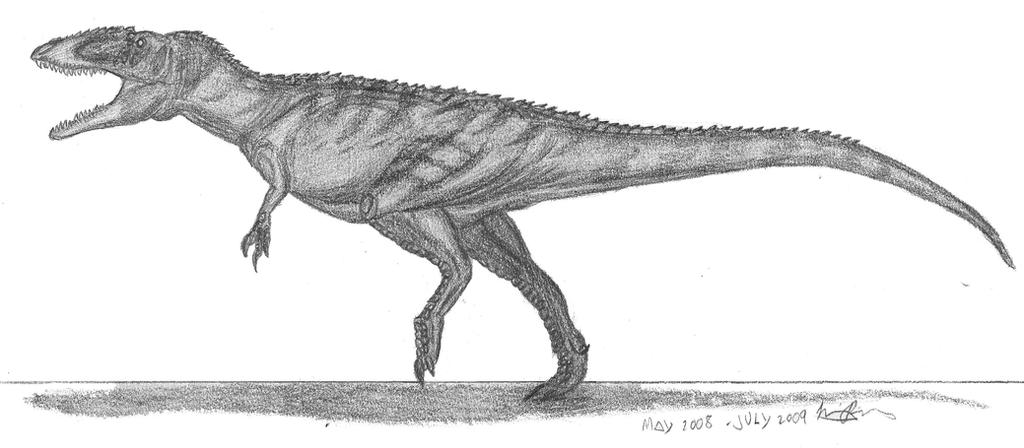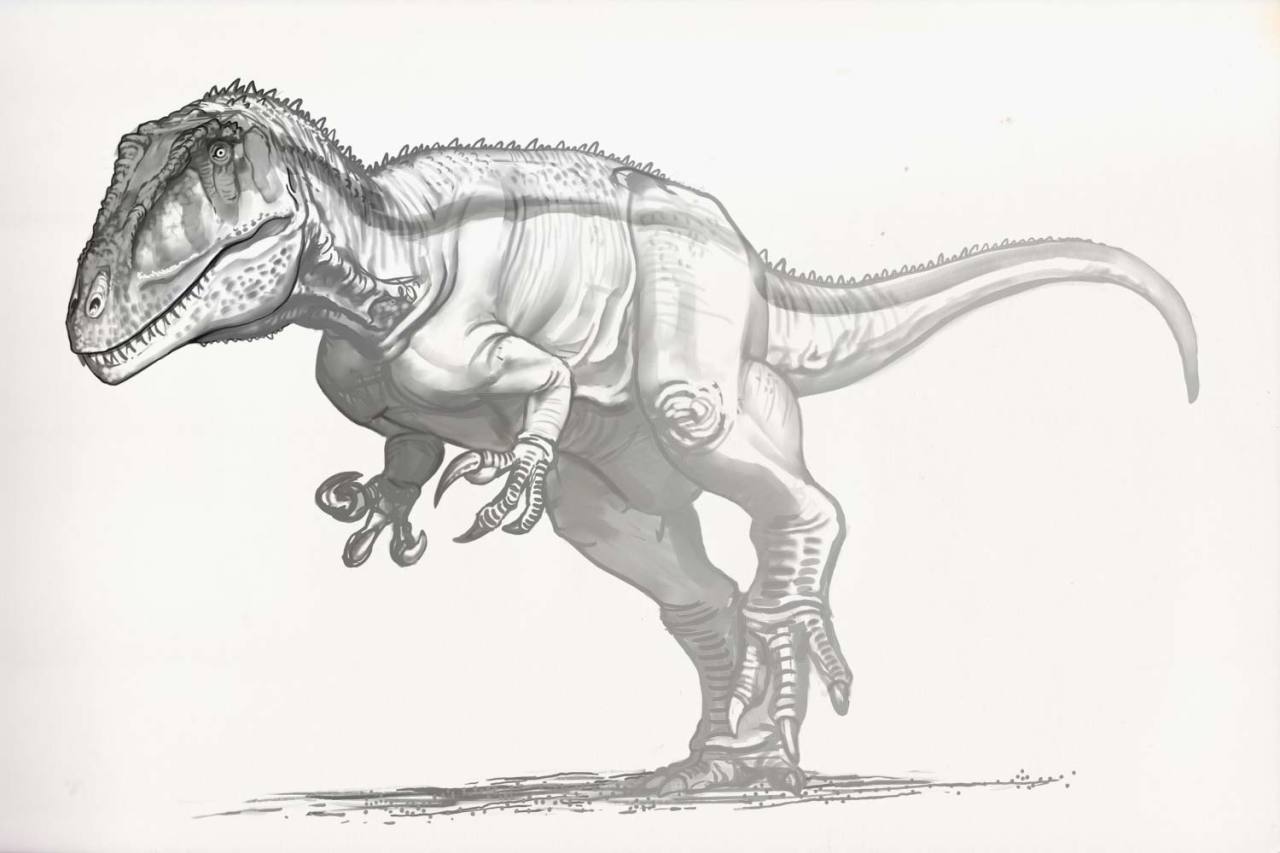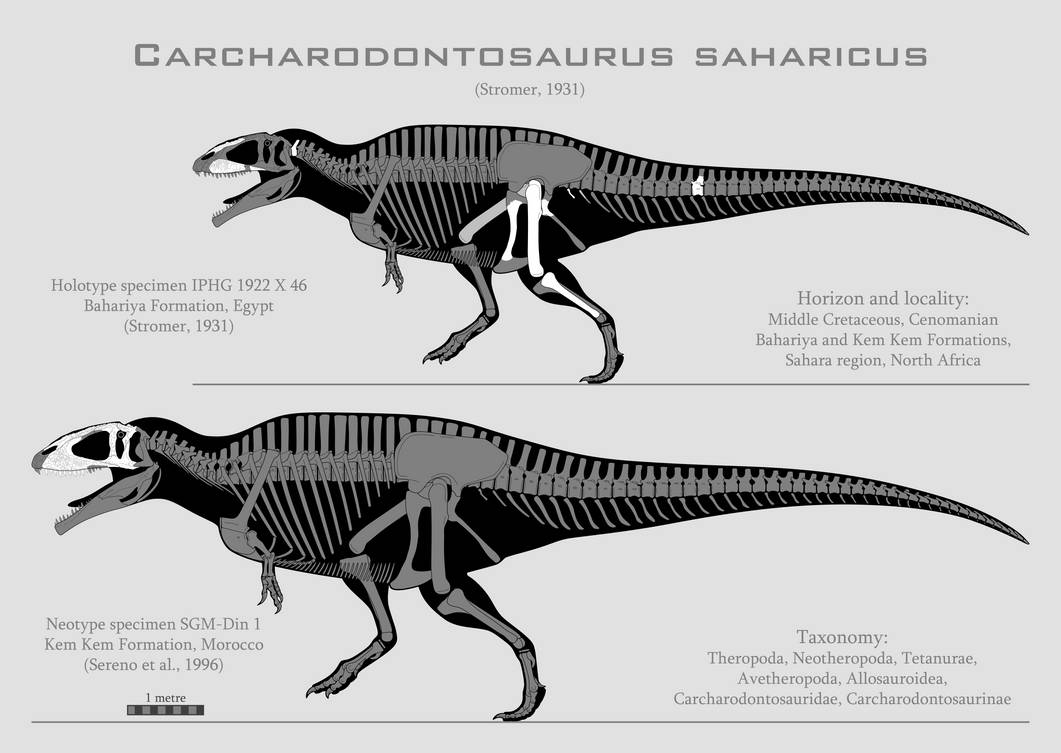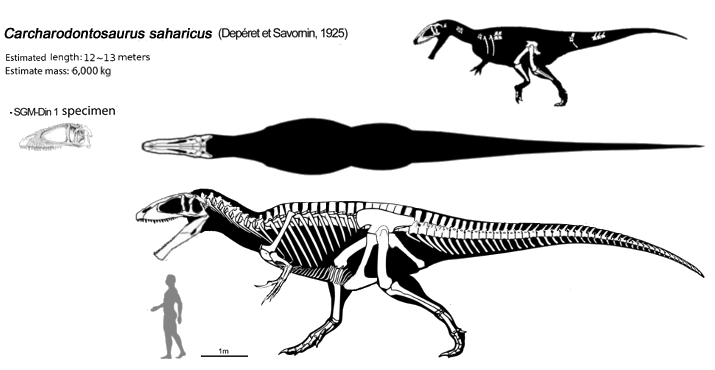Post by theropod on Mar 19, 2013 17:13:21 GMT 5
Carcharodontosaurus saharicus was a large species of Carcharodontosaur that lived during the late Cretaceous Cenomanian stage of the Kem Kem and Baharija Formations in Africa.

Artwork by EmperorDinobot (emperordinobot.deviantart.com/art/Carcharodontosaurus-saharicus-128230449)
The species was originally named in 1925 by Deperet and Savornin and became known as Dryptosaurus or Megalosaurus saharicus, based on isolated teeth (which are not diagnostic among Carcharodontosauridae). The genus Carcharodontosaurus was erected by Ernst Stromer in 1931, based on the strong resemblance of the replacement teeth he found in the holotype's maxilla to those of Carcharodon carcharias. However, as it turned out, fully developed teeth (reaching over 10cm in crown height in some specimens) are more recurved and less triangular, rendering the name somewhat unfitting.
Neotype: SGM DIN 1, partial skull (lacking quadrate, squamosals, quadratojugals, praemaxillae)
(Sereno et al. 1996)
Holotype/Genoholotype: IPHG 1922 X46 / BSP 1922 X46, consisting of a fragmentary skull, axial and appendicular skeleton (femur=1.26m), was destroyed during World War II
Referred: several specimens, mostly isolated teeth, one maxillary fragment, one cervical vertebra, ?ilium
Diagnosis: "laterally protruding ventral margin of the maxillary external antorbital fossa; deep and ventrally-facing fossa between
the inner wall of the maxilla and the anteromedial process; deep and dorsoventrally protruding lacrimal-frontal suture; invaginated anteromedial corner of the supratemporal fossa; distinct enamel wrinkles on both mesial and distal margins of mesial (anterior) and mid maxillary crowns."
Source: archosaur.us/theropoddatabase/Carnosauria.htm#Carcharodontosaurussaharicus
Morphology & Anatomy: The skull is long, narrow and deep. The antorbital fenestra is exceptionally large.
The teeth are relatively narrow, blade-like and very sharp, with the carinae exhibiting a slight curvature on the distal side of the tooth.
Little is known about this taxon's postcranial anatomy, however the lost holotype's description can give some clues. From the robusticity of the proximal caudal Stromer concluded the animal had a very strong tail base. This vertebra bears a pneumatopore, indicating extensive pneumatisation. The preserved pubis measured 80cm and may have exceeded 1m in the living animal.
The femur, at 126cm, appears to be large relative to the specimen's cranial remains and presumed overall size.
life reconstruction
Behaviour & Diet: We don't know much about the behaviour of these animals due to scarce fossil evidence.
A large number of the related Mapusaurusu roseae has been found together, possibly indicating a social lifestyle. Furthermore several carnosaurs exhibit cranial ornamentation, which could also point out to this.
Carcharodontosaurs are tought to have been specialized in hunting large prey like sauropods, by ripping large wounds and letting them bleed to death, based on their jaw morphology (sharp teeth and wide gapes).
Size:
No size estimates basing on valid metodology have ever been published in peer-review. 12m is a widespread figure in the media, however it is not from any of the papers published on it. Sereno himself gave 45ft (=13.7m=~14m) on his site and in a press release. Therrien and Henderson estimated it at 13.3m based on the skull lenght, however using an inconclusive method.
Published weight estimates are just as unreliable as lenght figures, but Allosaurus or Acrocanthosaurus can be assumed to be fitting scale models.
The neotype's skull as reconstructed by Sereno et al. is about 157cm long (rounded figure as usually cited is 1.6m). Carrano et al. gave a figure of 142cm " Using a reconstructed premaxilla based on those of Giganotosaurus and Mapusaurus", not stating the exact dimension, which is almost exactly the lenght of Sereno's skull from Premaxilla to Occipital condyle with a corrected premaxilla.
The holotype appears to be significantly smaller than the neotype going by the skull size:

reconstruction 1
reconstruction 2
My own reconstructions basing the unknown parts on Acrocanthosaurus, Giganotosaurus and Mapusaurus yield ~163cm for the largest dimension, those based just on Acrocanthosaurus ~157cm, both coincide with Carrano et al.’s figure given it is for the skull lenght in the saggittal plane.
To get an impression of the animal's size, Acrocanthosaurus can be used as a comparison, whose largest specimen (~11,5-12m in total lenght, Currie&Carpenter, 2000/Holtz "Dinoappendix") has a skull measuring ~129cm (Eddy&Clarke, 2011).
The more large skulled, derived Giganotosaurus may yield shorter lenght figures depending on how the crania are reconstructed respectively.
All sources regard Carcharodontosaurus saharicus as among the largest known theropods.
References/Literature:
Predatory Dinosaurs from the Sahara and Late Cretaceous Faunal Differentiation
Sereno et al., 1996
www.jstor.org/stable/pdfplus/2889583.pdf
Out of Africa: Meat-Eating Dinosaurs that Challenge Tyrannosaurus rex
Currie, 1996
www.jstor.org/stable/pdfplus/2889575.pdf
A New Species of Carcharodontosaurus (Dinosauria: Theropoda) from the Cenomanian of Niger and a Revision of the Genus
Brusatte & Sereno, 2007
www.researchgate.net/publication/232678470_A_NEW_SPECIES_OF_CARCHARODONTOSAURUS_%28DINOSAURIA_THEROPODA%29_FROM_THE_CENOMANIAN_OF_NIGER_AND_A_REVISION_OF_THE_GENUS
The phylogeny of Tetanurae (Dinosauria: Theropoda)
Carrano, Benson & Sampson, 2012
www.tandfonline.com/doi/abs/10.1080/14772019.2011.630927
Wirbeltierreste der Baharîje-Stufe (unterstes Cenoman) : Ein Skelett-Rest von Carcharodontosaurus nov. gen.
Stromer, 1931
www.paleoglot.org/files/Stromer_31.doc
(send me a mail if you want a scan of the original paper including the plate)
Zur systematischen Stellung der afrikanischen Theropoden Carcharodontosaurus Stromer 1931 und Bahariasaurus Stromer 1934
Rauhut, 1995
www.paleoglot.org/files/Rauhut_95.pdf
PaleoDB
paleodb.org/cgi-bin/bridge.pl?a=basicTaxonInfo&taxon_no=65365
The Theropod Database
Mortimer
archosaur.us/theropoddatabase/Carnosauria.htm#Carcharodontosaurussaharicus

Artwork by EmperorDinobot (emperordinobot.deviantart.com/art/Carcharodontosaurus-saharicus-128230449)
The species was originally named in 1925 by Deperet and Savornin and became known as Dryptosaurus or Megalosaurus saharicus, based on isolated teeth (which are not diagnostic among Carcharodontosauridae). The genus Carcharodontosaurus was erected by Ernst Stromer in 1931, based on the strong resemblance of the replacement teeth he found in the holotype's maxilla to those of Carcharodon carcharias. However, as it turned out, fully developed teeth (reaching over 10cm in crown height in some specimens) are more recurved and less triangular, rendering the name somewhat unfitting.
Neotype: SGM DIN 1, partial skull (lacking quadrate, squamosals, quadratojugals, praemaxillae)
(Sereno et al. 1996)
Holotype/Genoholotype: IPHG 1922 X46 / BSP 1922 X46, consisting of a fragmentary skull, axial and appendicular skeleton (femur=1.26m), was destroyed during World War II
Referred: several specimens, mostly isolated teeth, one maxillary fragment, one cervical vertebra, ?ilium
Diagnosis: "laterally protruding ventral margin of the maxillary external antorbital fossa; deep and ventrally-facing fossa between
the inner wall of the maxilla and the anteromedial process; deep and dorsoventrally protruding lacrimal-frontal suture; invaginated anteromedial corner of the supratemporal fossa; distinct enamel wrinkles on both mesial and distal margins of mesial (anterior) and mid maxillary crowns."
Source: archosaur.us/theropoddatabase/Carnosauria.htm#Carcharodontosaurussaharicus
Morphology & Anatomy: The skull is long, narrow and deep. The antorbital fenestra is exceptionally large.
The teeth are relatively narrow, blade-like and very sharp, with the carinae exhibiting a slight curvature on the distal side of the tooth.
Little is known about this taxon's postcranial anatomy, however the lost holotype's description can give some clues. From the robusticity of the proximal caudal Stromer concluded the animal had a very strong tail base. This vertebra bears a pneumatopore, indicating extensive pneumatisation. The preserved pubis measured 80cm and may have exceeded 1m in the living animal.
The femur, at 126cm, appears to be large relative to the specimen's cranial remains and presumed overall size.
life reconstruction
Behaviour & Diet: We don't know much about the behaviour of these animals due to scarce fossil evidence.
A large number of the related Mapusaurusu roseae has been found together, possibly indicating a social lifestyle. Furthermore several carnosaurs exhibit cranial ornamentation, which could also point out to this.
Carcharodontosaurs are tought to have been specialized in hunting large prey like sauropods, by ripping large wounds and letting them bleed to death, based on their jaw morphology (sharp teeth and wide gapes).
Size:
No size estimates basing on valid metodology have ever been published in peer-review. 12m is a widespread figure in the media, however it is not from any of the papers published on it. Sereno himself gave 45ft (=13.7m=~14m) on his site and in a press release. Therrien and Henderson estimated it at 13.3m based on the skull lenght, however using an inconclusive method.
Published weight estimates are just as unreliable as lenght figures, but Allosaurus or Acrocanthosaurus can be assumed to be fitting scale models.
The neotype's skull as reconstructed by Sereno et al. is about 157cm long (rounded figure as usually cited is 1.6m). Carrano et al. gave a figure of 142cm " Using a reconstructed premaxilla based on those of Giganotosaurus and Mapusaurus", not stating the exact dimension, which is almost exactly the lenght of Sereno's skull from Premaxilla to Occipital condyle with a corrected premaxilla.
The holotype appears to be significantly smaller than the neotype going by the skull size:

reconstruction 1
reconstruction 2
My own reconstructions basing the unknown parts on Acrocanthosaurus, Giganotosaurus and Mapusaurus yield ~163cm for the largest dimension, those based just on Acrocanthosaurus ~157cm, both coincide with Carrano et al.’s figure given it is for the skull lenght in the saggittal plane.
To get an impression of the animal's size, Acrocanthosaurus can be used as a comparison, whose largest specimen (~11,5-12m in total lenght, Currie&Carpenter, 2000/Holtz "Dinoappendix") has a skull measuring ~129cm (Eddy&Clarke, 2011).
The more large skulled, derived Giganotosaurus may yield shorter lenght figures depending on how the crania are reconstructed respectively.
All sources regard Carcharodontosaurus saharicus as among the largest known theropods.
References/Literature:
Predatory Dinosaurs from the Sahara and Late Cretaceous Faunal Differentiation
Sereno et al., 1996
www.jstor.org/stable/pdfplus/2889583.pdf
Out of Africa: Meat-Eating Dinosaurs that Challenge Tyrannosaurus rex
Currie, 1996
www.jstor.org/stable/pdfplus/2889575.pdf
A New Species of Carcharodontosaurus (Dinosauria: Theropoda) from the Cenomanian of Niger and a Revision of the Genus
Brusatte & Sereno, 2007
www.researchgate.net/publication/232678470_A_NEW_SPECIES_OF_CARCHARODONTOSAURUS_%28DINOSAURIA_THEROPODA%29_FROM_THE_CENOMANIAN_OF_NIGER_AND_A_REVISION_OF_THE_GENUS
The phylogeny of Tetanurae (Dinosauria: Theropoda)
Carrano, Benson & Sampson, 2012
www.tandfonline.com/doi/abs/10.1080/14772019.2011.630927
Wirbeltierreste der Baharîje-Stufe (unterstes Cenoman) : Ein Skelett-Rest von Carcharodontosaurus nov. gen.
Stromer, 1931
www.paleoglot.org/files/Stromer_31.doc
(send me a mail if you want a scan of the original paper including the plate)
Zur systematischen Stellung der afrikanischen Theropoden Carcharodontosaurus Stromer 1931 und Bahariasaurus Stromer 1934
Rauhut, 1995
www.paleoglot.org/files/Rauhut_95.pdf
PaleoDB
paleodb.org/cgi-bin/bridge.pl?a=basicTaxonInfo&taxon_no=65365
The Theropod Database
Mortimer
archosaur.us/theropoddatabase/Carnosauria.htm#Carcharodontosaurussaharicus















